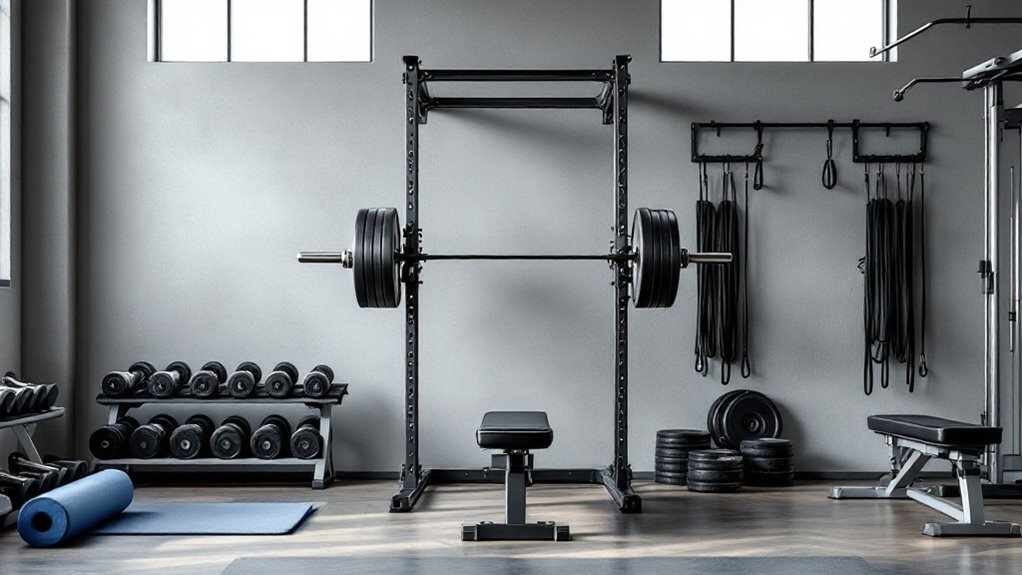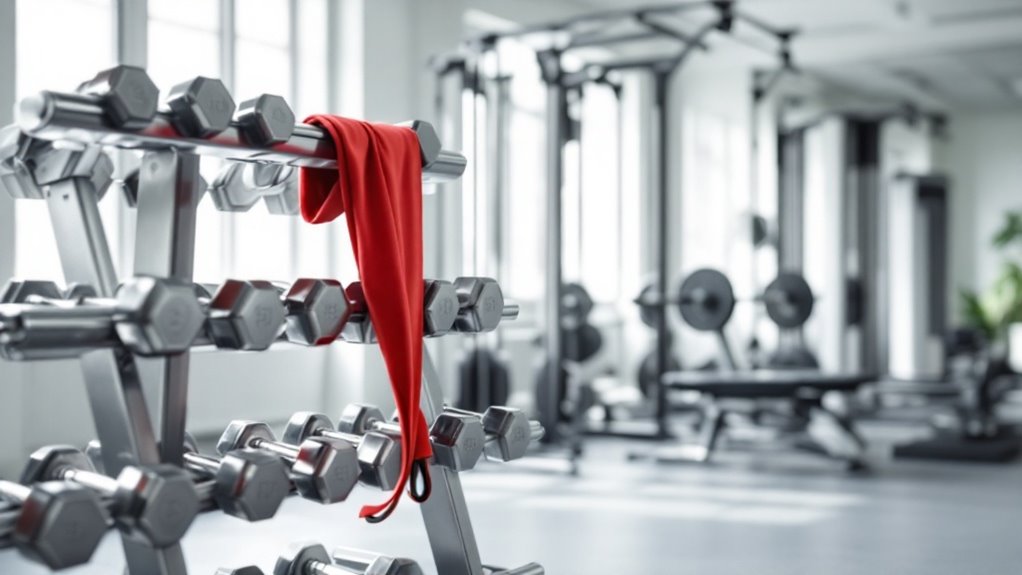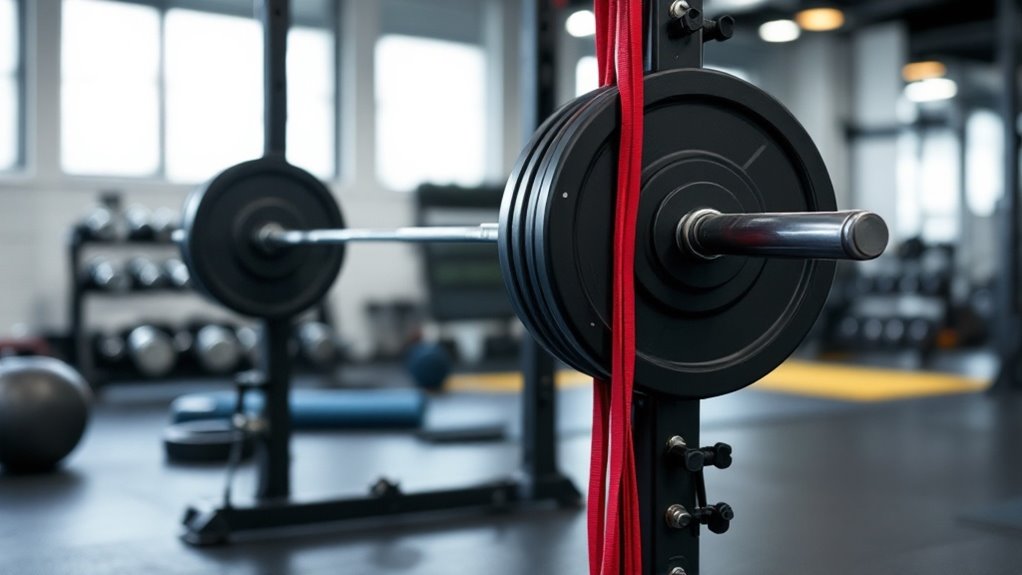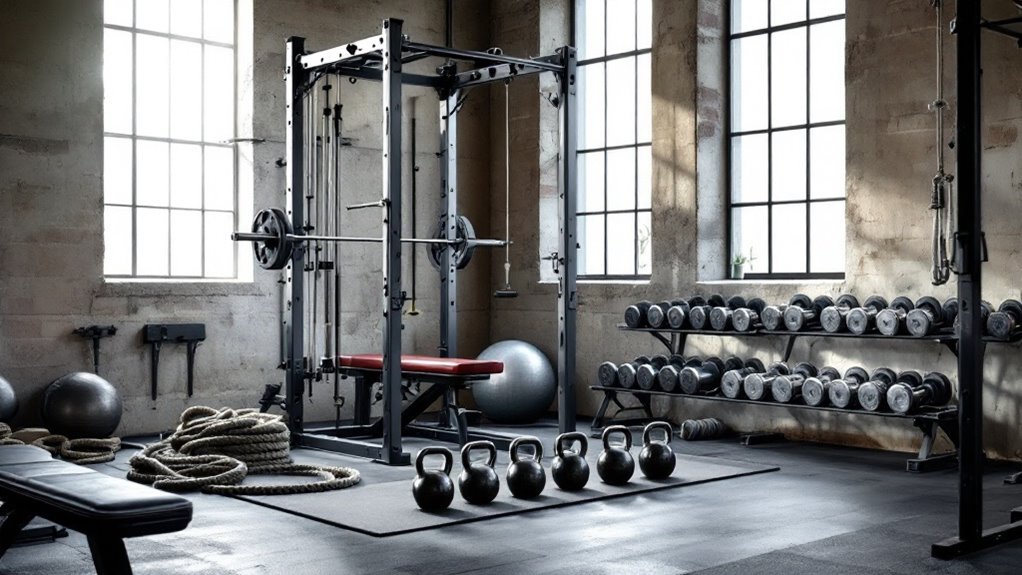Gym Equipment Workout Routine

A thorough gym workout routine starts with essential equipment: free weights, machines, and cardio stations. The foundation includes dumbbells, barbells, and a power rack for compound movements. Proper form remains vital, with controlled movements and appropriate breathing patterns. Strategic equipment combinations enhance results through supersets and intervals. Success comes from progressive overload while maintaining safety guidelines. Exploring these fundamentals reveals the path to sustainable fitness progress.
Key Takeaways
- Start with a 5-10 minute cardio warm-up using treadmill or stationary bike before moving to strength training equipment.
- Alternate between upper and lower body exercises using free weights and machines to allow proper muscle recovery.
- Perform compound movements first using power racks and barbells, then progress to isolation exercises with dumbbells and cables.
- Include 3-4 exercises per major muscle group with 3 sets of 8-12 repetitions each for balanced development.
- Schedule rest periods of 60-90 seconds between sets while maintaining proper form and breathing patterns.
Essential Gym Equipment for a Full-Body Workout

While building an effective workout routine requires dedication and proper form, having access to the right gym equipment is equally essential for achieving ideal results.
A well-equipped gym should include both free weights and machines to target every major muscle group.
Essential equipment includes dumbbells, barbells, and weight plates for strength training. A power rack or squat rack enables safe compound movements.
Cable machines offer versatile resistance training options. For cardiovascular fitness, treadmills, stationary bikes, and rowing machines are fundamental.
Additional must-have items include adjustable benches, resistance bands, and foam rollers for mobility work.
This combination of equipment provides a solid foundation for any thorough workout program.
Starting with low-impact activities helps prevent injury when returning to exercise after a period of inactivity.
Creating Your Equipment-Based Exercise Plan

A strategic equipment-based exercise plan serves as the blueprint for achieving fitness goals efficiently and effectively.
Creating a structured routine involves selecting specific machines and equipment that target all major muscle groups while maintaining proper progression.
To develop a thorough plan, individuals should start by identifying their primary fitness objectives, whether building strength, enhancing endurance, or improving overall fitness.
Next, they should schedule workout days, allocating specific equipment for each muscle group. The plan should incorporate progressive overload principles, gradually increasing weights or repetitions.
Including rest periods between sets and alternating muscle groups helps optimize recovery while maintaining workout intensity.
For beginners, focusing on proper exercise form before increasing weights is essential to prevent injury and maximize results.
Proper Form and Safety Guidelines

Proper exercise form and safety protocols serve as the fundamental building blocks for injury prevention and ideal training results. Following established guidelines guarantees maximum effectiveness while minimizing the risk of injury during equipment-based workouts.
| Safety Element | Key Guidelines |
|---|---|
| Equipment Check | Inspect machines for damage before use |
| Form Focus | Maintain neutral spine and controlled movements |
| Weight Selection | Start light and progress gradually |
| Breathing Pattern | Exhale during exertion, inhale during return |
Understanding and implementing these safety measures creates a solid foundation for sustainable fitness progress. Proper form not only protects against injury but also assures targeted muscle involvement for peak results. Incorporating progressive overload principles helps ensure continued strength gains while maintaining proper form and safety standards.
Maximizing Results With Equipment Combinations

Strategic equipment combinations release powerful synergies that improve workout effectiveness beyond what single machines can provide.
Pairing cable machines with free weights creates dynamic tension throughout movements. Combining battle ropes with kettlebells drives intense metabolic conditioning.
Blending equipment types maximizes workout intensity and muscle activation, from steady cable resistance to explosive kettlebell-rope combinations.
For best results, supplement heavy compound lifts on power racks with isolation work on machines.
Mix stability balls with bench presses to involve core muscles. Stack cardio intervals between strength supersets using adjacent equipment setups.
Smart equipment pairings optimize time efficiency and muscle involvement while maintaining proper form.
The key is selecting complementary tools that target different movement patterns within the same muscle groups.
Focus on mastering proper exercise form before increasing weights to build muscle safely and prevent injuries.
Frequently Asked Questions
How Long Should I Rest Between Sets When Using Different Gym Equipment?
Rest periods between sets depend on training goals and exercise intensity.
For strength training with heavy weights, rest 2-3 minutes to allow full recovery.
Moderate-intensity exercises require 60-90 seconds rest.
For endurance or fat loss, keep rest periods shorter at 30-45 seconds.
Advanced lifters may need longer rest for compound movements.
Beginners should focus on proper form and adjust rest based on fatigue levels.
Can I Use the Same Gym Equipment Every Day?
Using the same gym equipment daily isn't recommended.
Muscles need 24-48 hours to recover and rebuild after intense workouts. Instead, athletes should rotate between different muscle groups and equipment.
Monday might focus on chest machines, Tuesday on leg equipment, and Wednesday on back exercises.
This rotation prevents overuse injuries, allows proper recovery, and optimizes strength gains while maintaining steady progress in overall fitness development.
Should I Wipe Down Equipment Before or After Use, or Both?
Wiping down equipment both before and after use is the best approach for gym hygiene.
Before use protects against other people's sweat and bacteria, while after-use cleaning shows respect for fellow gym members. Most gyms provide sanitizing stations with spray bottles and paper towels.
This dual-cleaning approach helps prevent the spread of germs, skin infections, and other communicable conditions in the shared workout environment.
What's the Best Time of Day to Use Gym Equipment?
Like a skilled hunter choosing the perfect moment to strike, timing your gym session can optimize results.
Research indicates early morning workouts (5-7 AM) boost metabolism and consistency, while afternoon sessions (2-6 PM) correspond with peak body temperature and strength potential.
However, the best time fundamentally depends on individual schedules and energy patterns. The key is selecting a time that can be maintained consistently.
How Many People Can Safely Share a Piece of Equipment Simultaneously?
Most gym equipment is designed for individual use, with one person exercising at a time.
However, certain pieces like cable machines can safely accommodate two people simultaneously when using different attachments. Smith machines and power racks may allow partner workouts with proper spacing and communication.
For safety and peak performance, it's recommended to maintain single-user operation on free weights, cardio machines, and isolation equipment.
Final Thoughts
Like a master craftsman selecting the perfect tools, building an effective gym equipment routine requires careful planning and dedication. The path to fitness mastery combines strategic equipment selection, proper form, and intelligent exercise combinations. By following these guidelines, anyone can transform their workout space into their personal fortress of strength. Remember, as the ancient Greeks knew well: a sound mind flourishes in a well-trained body.


